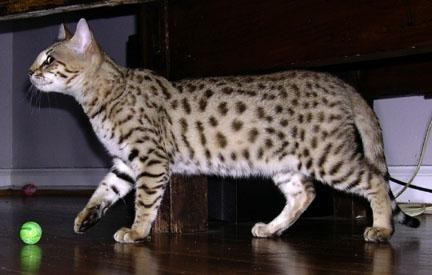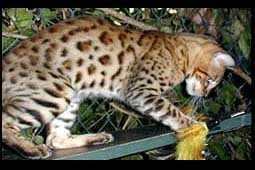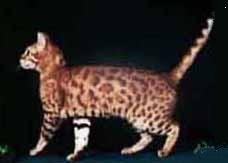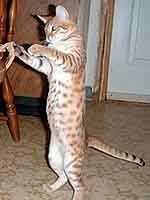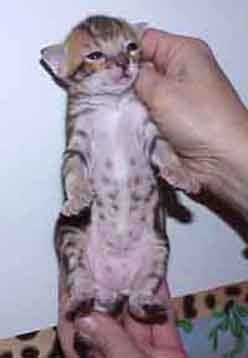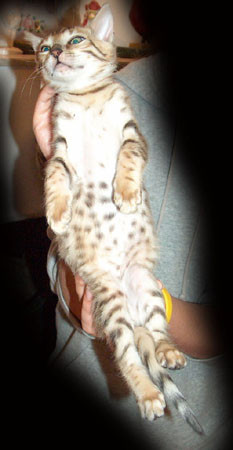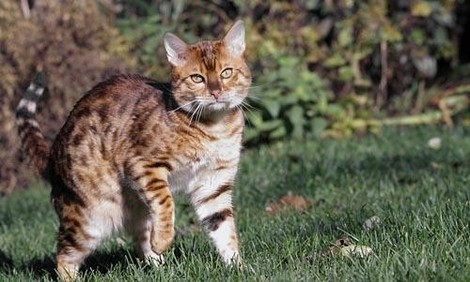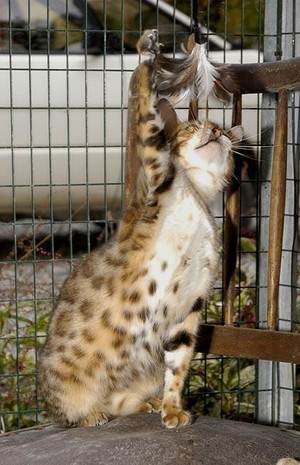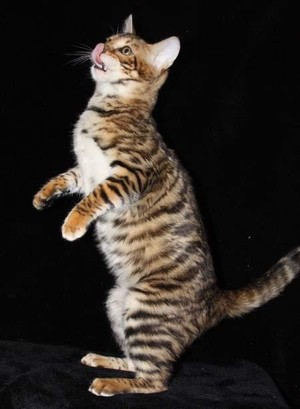Whited Tummy
The Whited Underbody © by Marc King - All Rights Reserved, ALL IMAGES USED WITH PERMISSION
ALC WHITED UNDERBODY PATTERN - THE SEARCH © 2000 by Marc King - All Rights Reserved!
In a period of extensive research before making purchases to start our Bengal cattery in 2000, it became apparent that there was something visually missing in achieving the true "leopard look" in Bengals, i.e., the beautiful underbody pattern that was seen in the ALC. Hundreds of hours were spent researching, searching for what had happened to this beautiful aspect of the ancestors of the Bengal cat.
By ALC underbody pattern, I mean the true brilliant (almost blue-grey) "t-shirt" whited (not light cream or pale beige/light brown color) area all under the body of the cats, as seen in most spotted felines, from Cheetahs to Marbled Cats. This factor seemed to have completely disappeared from SBT-level cats, rarely resurfacing again. My search then started in earnest to find out more about this phenomenon.
In a period of extensive research before making purchases to start our Bengal cattery in 2000, it became apparent that there was something visually missing in achieving the true "leopard look" in Bengals, i.e., the beautiful underbody pattern that was seen in the ALC. Hundreds of hours were spent researching, searching for what had happened to this beautiful aspect of the ancestors of the Bengal cat.
By ALC underbody pattern, I mean the true brilliant (almost blue-grey) "t-shirt" whited (not light cream or pale beige/light brown color) area all under the body of the cats, as seen in most spotted felines, from Cheetahs to Marbled Cats. This factor seemed to have completely disappeared from SBT-level cats, rarely resurfacing again. My search then started in earnest to find out more about this phenomenon.
The Only Exceptions
At first, the only exceptions found were a number of F1 and F2 filial queens and a very small handful of hot sorrel SBTs. But then a few others caught my eye: F3s and SBTs that had varying degrees of true whited underbody patterns. But they were rare. This fueled a personal vision to set this as our goal in breeding Bengals, and the quest began to put together a group of carefully selected cats that would assist in reaching this goal. Easily dreamed, difficult to realize!
Whited Belly??
It became apparent rather quickly that the term "whited belly" was not used to mean the same thing in each case where it was mentioned, nor were conclusive scientific evidence or precise genetic patterns of inheritance available to study on the ALC white underbody pattern.
At first, the only exceptions found were a number of F1 and F2 filial queens and a very small handful of hot sorrel SBTs. But then a few others caught my eye: F3s and SBTs that had varying degrees of true whited underbody patterns. But they were rare. This fueled a personal vision to set this as our goal in breeding Bengals, and the quest began to put together a group of carefully selected cats that would assist in reaching this goal. Easily dreamed, difficult to realize!
Whited Belly??
It became apparent rather quickly that the term "whited belly" was not used to mean the same thing in each case where it was mentioned, nor were conclusive scientific evidence or precise genetic patterns of inheritance available to study on the ALC white underbody pattern.
Indeed, the whited pattern seems to continue to avoid nailing down to a specific genetic behavior. After numerous hours speaking with breeders in America, Canada, Germany, and Sweden, it seems safe to say, however, that the ALC whited underbody has behaved as an easily modified dominant gene complex (it seemed recessive because breeders who had this phenomenon repeatedly said "it just showed up"). Since the first publishing of this article, however, my assessment of this phenotype has changed.) This would mean that a whited Bengal mated with another whited Bengal would render all their offspring whited. This has proven not to be the case in breeding results. The results I have found of whited bred to true whited SBTs have not always resulted in 100% true whited offspring. An example:
We have with us here in Italy, for example, a long-desired young SBT girl from one of the very few catteries in the world working with whited-to-whited breeding. Both parents are whited, and this female was very white as a kitten. Her kitten-age whited expression is now, however, modified to a light tan. She only has hints of pure white - a pattern I described below (in pattern No. 1).
Another young female with us from at least three generations of whited bred to whited has, however, a pure T-shirt white underbody (pattern No. 4 below). This would/could also indicate that the pooling of these genes or groups of genes with ALC pattern modifiers (reducing the effect of tabby gene modifiers on the white underbody pattern), selecting according to phenotype, is possible. It would also seem that there is the possibility to breed homozygous, whited underbodied Bengals! My vision. Because so few breeders have had the fortune or privilege to have the whited expressions or true white underbody patterned cats in their breeding stock, there is very little previous experience to refer to and work with. Those that I am in contact with that have had some experience with whited underbody patterns emerging in their breeding programs usually said, "It just showed up. I did not select for it." There is one cattery in particular, however, that has been working exclusively on the whited expression for more than a decade, and it is from them that I learned the most and am most grateful.
We have with us here in Italy, for example, a long-desired young SBT girl from one of the very few catteries in the world working with whited-to-whited breeding. Both parents are whited, and this female was very white as a kitten. Her kitten-age whited expression is now, however, modified to a light tan. She only has hints of pure white - a pattern I described below (in pattern No. 1).
Another young female with us from at least three generations of whited bred to whited has, however, a pure T-shirt white underbody (pattern No. 4 below). This would/could also indicate that the pooling of these genes or groups of genes with ALC pattern modifiers (reducing the effect of tabby gene modifiers on the white underbody pattern), selecting according to phenotype, is possible. It would also seem that there is the possibility to breed homozygous, whited underbodied Bengals! My vision. Because so few breeders have had the fortune or privilege to have the whited expressions or true white underbody patterned cats in their breeding stock, there is very little previous experience to refer to and work with. Those that I am in contact with that have had some experience with whited underbody patterns emerging in their breeding programs usually said, "It just showed up. I did not select for it." There is one cattery in particular, however, that has been working exclusively on the whited expression for more than a decade, and it is from them that I learned the most and am most grateful.
ALC Whited vs. Tabby Lockets
An important aspect of this particular white pattern in our domestic breed of cat is its difference to the solid, crisply-contrasting white of some of the tabby patterns, i.e., lockets. The ALC whited phenotype displays a pure white area but with dark spots with its edges blended softly (a softer edge) along the ground color of the body, without hard, crisp separations of color. There is also a "tabby white chin" and body lockets in which a brilliant white, spotless area may appear, both of which are not allowed in our Bengals.
An important aspect of this particular white pattern in our domestic breed of cat is its difference to the solid, crisply-contrasting white of some of the tabby patterns, i.e., lockets. The ALC whited phenotype displays a pure white area but with dark spots with its edges blended softly (a softer edge) along the ground color of the body, without hard, crisp separations of color. There is also a "tabby white chin" and body lockets in which a brilliant white, spotless area may appear, both of which are not allowed in our Bengals.
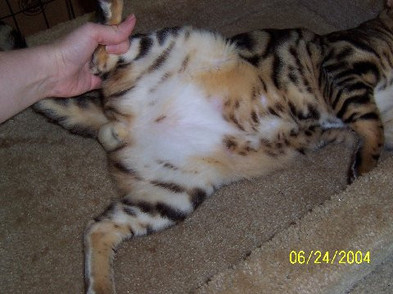
Above – locketed and not "whited" cats – there are no markings in a locket, there are always markings in ALC whited patterns
Hot Sorrels and Marbles
It is important to say that for years only a small handful of hot sorrels have demonstrated a clean white, extended ALC underbody pattern, and that few of the other colors displayed this refinement up until recently. Historically speaking, the hot sorrels Millwood French Lace, Sutera Labu, and Millwood Midas Touch figure predominantly in whited pedigrees that were found. I often thought to not introduce the hot sorrel color into our breeding foundation because of lack of contrasts in their body patterns, but quickly determined by studying numerous pedigrees that hot sorrels figure in the genotypes of most true whited SBT Bengals of any color. I do not understand the genetic cocktail that made up all what we call Bengals, but it also became obvious in this study that some of the most brilliantly whited Bengals are/were also in the marbled patterns (Sutera Gentry, Kingsmark Tantra, Rainforest Monkey Puzzle, Starbengal Banderas) and that perhaps we have marbles to thank for the reintroduction of this gene complex into some programs.
Patterns of the ALC Whited Underbody and Whited Expressions
When the white underbody pattern is extant, again here stressing the pure white color and not a lighter or creamy shade of the ground color, there seem to be numerous modifiers from the genes introduced in the creation of the Bengal that determine the extent of the whited expression. It is important to note here that in all cases of the ALC whited underbody pattern there are black to dark spots in the light field of color. If the spots are missing and the underbody pattern pure white, it was considered by most breeders as a locket inherited from the tabby.
For my own personal understanding of this underbody pattern, I created a few categories of the modified ALC whited underbody pattern in the whited Bengals I was able to gather information on:
When the white underbody pattern is extant, again here stressing the pure white color and not a lighter or creamy shade of the ground color, there seem to be numerous modifiers from the genes introduced in the creation of the Bengal that determine the extent of the whited expression. It is important to note here that in all cases of the ALC whited underbody pattern there are black to dark spots in the light field of color. If the spots are missing and the underbody pattern pure white, it was considered by most breeders as a locket inherited from the tabby.
For my own personal understanding of this underbody pattern, I created a few categories of the modified ALC whited underbody pattern in the whited Bengals I was able to gather information on:
1) The most common lighter underbody pattern is what Carol Effinger referred to me as "whited expression" (coined by Libbie Kerr), i.e., traces or influences of the true white underbody pattern. This category is the reduction of the original ALC white underbody pattern to a small portion of the inside of the legs, a very small part of the chest, perhaps a slight lightening of the ground color around the eyes, and touches of white in between the back legs, i.e., in the groin area. Cream or light beige is often the predominant color in the underbody. Interestingly enough, the chin and jaws are often white. In this category, there is also often a thin strip of white on the belly, connecting the chest area with the groin whited area. Sometimes this strip reduces to just a lighter shade of the ground color as the cat matures or disappears altogether. The collar area across the chest, i.e., above the ribcage and below the chin, is the same as the ground color of the back and head. This whited expression is sometimes overlooked because of its lack of visibility unless the cat is on its back with its legs stretched out. This pattern is often the result of whited x non-whited mating. This pattern can also be an extensive area of creamed or browned-over cream, the results of modifiers muting an area of kitten-age white.
2) The next pattern "up the ALC ladder" would be a noticeable increase of white in the chest area, widening up into the neck, up into the face, and extending down the inside of the legs. The groin area of white is larger, with a clear "hourglass" whited expression on the belly, connecting the chest and groin whited areas. This pattern usually has a distinct, sometimes wide "browned collar" across the chest from the shoulders, where the black necklaces of the ALC cross the white underbody pattern. In this type, sometimes the original black ALC necklace patterns are present, but the necklaces are usually brown. This whited pattern is usually only visible when the cat is lying down or raising its paws to show the insides of the legs.
3) The next pattern group would be with pure white flowing up through the face, on the cheeks, and around the eyes with white or very light "spectacles," giving a distinct impression of white when the cat looks at you. From the hourglass whited belly, the pattern would extend up from the groin to near the tip of the tail underneath, extending to cover the entire inner legs (becoming very visible when viewed from behind) and also extend further down the neck to the collar and necklaces, if present. This pattern is very attractive in that the white is easily seen when the cat is walking and playing. A good example of this type is Rosetta's Pawprint.
4) The last group - and the rarest I've found in SBTs - is basically the above whited pattern with the white on the belly extending from ribcage to ribcage, i.e., fully visible from the sides of the cat in a standing position, combined with a reduction of the browned collar across the throat. I have only seen 3 or 4 Bengals at the SBT level that possessed this pattern, one of which is an F4 now touring the United States and bedazzling judges and onlookers alike!
5) The ALC pattern. Wide brilliant white with jet black necklaces and black spots without any trace of a browned collar. It is also important to note that the pure ALC pattern is always accompanied with pink paw pads and that we should perhaps reconsider the accepted colors of paw pads when setting the ALC whited underbody pattern as our goal in Bengals.
Extent of Underbody Pattern
This may also be a bit far-fetched assumption, but the best whited expressions of type No 4 - the wide, easily-seen-from-the-sides of the cat pattern - I have found in non-hot sorrels were mostly in 2 ALC lines so far - one particular line from ALC Taro and one from ALC Phantom. The two widest, most spectacularly whited SBTs I found in this ongoing research were from the Phantom line. There are also many whited from the Kabuki lines, predominantly of the pattern types 2 - 3. In an attempt to combine the best genetic basis for our foundation, we hoped and were very gratefully able to procure some of these three lines. A particular high-point in this search for more of the true ALC whited patterned was discovering at the F3 level a single Phantom filial queen (literally in looking up and at thousands of Bengals) that has actually kept the exact ALC whited expression with a rich rufous mahogany-orange ground color, black necklaces and shaded rosettes and NO HINT of a browned collar. A complete one-of-a-kind find, and, of course, we are now on the waiting list for an F3 girl from this fabulously patterned Bengal!
ALC white underbody pattern... the search, continued from previous page © by Marc King - all rights reserved, ALL IMAGES USED WITH PERMISSION
Whited Expression
The results of other breeders who have worked with the ALC whited factor have shown that often the underbody color will or can indeed be lightened by the presence of these genes in the genotype of the cat, i.e., when mating a true whited hot sorrel, for example, with a "light tummied" SBT, often the results were an even lighter underbody. The true ALC white is, however, a clean "T-shirt" white and not to be confused with light cream, beige, light tan, etc. Cats showing whited expressions have been very important in the extension of the breeding basis for the true whited underbody pattern.
Ground Color Influence
With the lack of genetic research and authoritative opinions on this aspect, I am writing my assumptions based on the breeding results of numerous others. Here I have Carol Effinger (Sutera Bengals), Lisay Arvay (Rosetta Bengals), Jean Mill, Annette Trolle (Trollspotting Bengals), and others to thank for many patient hours of question/answers. The ground colors of our Bengals seem to have a distinct and pronounced influence on the visual clarity and extent of the whited factor. The highly glittered, red mahogany-brown to browned-orange (more richly-pigmented rufous spectrum) colors seem to possess higher concentrations of modifiers that darken or reduce the whited expression and, so far, the non-glittered wheaten, light gold, yellow-bronze ground colors seem to have a more confined, stable pattern when in combination with the whited pattern, i.e., not migrating as far into the underbody pattern. This is not always the case, of course; the Phantom F2 and 3's mentioned earlier are a richly browned rufous with black pattern. There are, however, glittered beige, tan, and lighter, cooler colors which have had true whited ALC underbody patterns. Glitter was inherited independently of color; clean and pure white seemingly were not. Not at this stage.
Many ALCs are being used today in the creation of new lines, and most ALCs are not the best influence on color and pattern in our already stunning breed, Bengals now having surpassed many ALCs in rosetted patterns. All ALCs I have ever seen or in pictures are drab beige, tan, greyish, and ticked cool colors. There are very few ALCs which show a definitive "red" color as seen in Dehli descendants. Even though it has been stated many times that ALCs from the tropical regions have brighter, orange, and gold-yellow colors, there has yet to surface such an ALC in a Bengal program. (Author's opinion)
Most of the numerous richly-rufoused (mahogany red to ruddy Abyssinian) colors, whited-looking kittens purchased, viewed, and/or researched for this article lost their whited underbody pattern by full sexual maturity. Some of these kittens kept the much lighter chin and spectacles like in the red Abyssinian ruddy color pattern, giving the impression of the whited expression in the face only. The color descriptor "rufous" is also difficult to nail down, but a simple explanation told to me sums it up well: rufous is like iodine - the thinner the application, the more yellow-bronze the color, the thicker the application, the more mahogany red the color becomes. It seems that the higher the concentration of red, the higher the concentration of underbody color modifiers. The best whited examples to date had the ground colors: wheaten, light brown, golden, bronze, sorrel, beige, tan, etc. - in other words, the lighter and "cooler" colors. It also seems, visually speaking, that the richly rufoused, "ruddy" Abyssinian color, complete with its lighter to near-white chin, spectacles, and evenly-reddish underbody, is the same genetic red as in many of our red-rufous Bengals. We know that the foundational Millwood Dehli was a richly rufoused, which contributed to both glitter and red in the breed today, but also that Abyssinians were employed in the first filial foundations. We do not know, however, what the genetic makeup for Dehli's red pigmentation was.
Snows
Some snows seem to be whited due to their temperature-sensitive expression of the color point genetics, the warmer areas lightening, the cooler areas darkening, with their underbodies being sometimes many degrees lighter than their overall body color. This should not be confused, however, with the ALC whited underbody pattern described here. Many breeders told me in my search for whited cats or parents of kittens, that their snows were their only whiteds, so this aspect may be easily confused with the true whited ALC underbody pattern. I have found, interestingly enough, a concentration of whited expression patterns in BSTs in certain lines in a few American and European pedigrees (in particular in the UK, Denmark, and Holland) with Lynx, Mink, and Sepia snows in their genotype. An excellent example of this is the breeding program of Annette Trolle of Trollspotting in Denmark.
Selecting for the Whited Underbody Pattern
In breeding and selecting for ALC whited patterns, the true test is to wait out full maturity of the cat that showed the right phenotype as a kitten, perhaps 1.5 - 2 years, before considering it "ALC whited". Then, one would breed only with such cats, but... due to the rapid pace at which many catteries change out breeding animals, perhaps this aspect will be one of the slowest to be developed in the Bengals of tomorrow. Most people don't want to tend to a cat for such a period of time before deciding its final place. As a plant breeder, I often wait out 4 - 6 years of evaluation before judging the results and deciding what to employ further in breeding.
Selecting Kittens
Many Bengal kittens seem to have whited underbodies because they are usually very light to white underneath, but this often changes rapidly at sexual maturity to the ground color of the upper body. It seems obvious that the modifiers "kick in" at certain stages of development, as is with the coat colors of Bengals, and what looks like ALC whited underbody pattern creams out or darkens. It has been a very frustrating experience in the search for the true whited expression to be proposed or even sold kittens as "true whited" when they were simply in the kitten coat with lighter underbody. The true test, as mentioned, is to wait out full maturity of the cat, at least 1.5 years (better 2 full years), to even describe it as "true whited". It would be more honest to describe the others as just "lighter" in the underbody pattern. Choosing a kitten from two, fully-mature whited parents is one's best bet. As previously mentioned, white x white breedings are already slowly becoming a possibility, but not a 100% probability of true whited offspring. According to 2 experienced breeders, a few factors to look for when suspecting the presence of a true whited kitten is a bright pink, practically naked underbody at birth with black to dark spots.
This may also be a bit far-fetched assumption, but the best whited expressions of type No 4 - the wide, easily-seen-from-the-sides of the cat pattern - I have found in non-hot sorrels were mostly in 2 ALC lines so far - one particular line from ALC Taro and one from ALC Phantom. The two widest, most spectacularly whited SBTs I found in this ongoing research were from the Phantom line. There are also many whited from the Kabuki lines, predominantly of the pattern types 2 - 3. In an attempt to combine the best genetic basis for our foundation, we hoped and were very gratefully able to procure some of these three lines. A particular high-point in this search for more of the true ALC whited patterned was discovering at the F3 level a single Phantom filial queen (literally in looking up and at thousands of Bengals) that has actually kept the exact ALC whited expression with a rich rufous mahogany-orange ground color, black necklaces and shaded rosettes and NO HINT of a browned collar. A complete one-of-a-kind find, and, of course, we are now on the waiting list for an F3 girl from this fabulously patterned Bengal!
ALC white underbody pattern... the search, continued from previous page © by Marc King - all rights reserved, ALL IMAGES USED WITH PERMISSION
Whited Expression
The results of other breeders who have worked with the ALC whited factor have shown that often the underbody color will or can indeed be lightened by the presence of these genes in the genotype of the cat, i.e., when mating a true whited hot sorrel, for example, with a "light tummied" SBT, often the results were an even lighter underbody. The true ALC white is, however, a clean "T-shirt" white and not to be confused with light cream, beige, light tan, etc. Cats showing whited expressions have been very important in the extension of the breeding basis for the true whited underbody pattern.
Ground Color Influence
With the lack of genetic research and authoritative opinions on this aspect, I am writing my assumptions based on the breeding results of numerous others. Here I have Carol Effinger (Sutera Bengals), Lisay Arvay (Rosetta Bengals), Jean Mill, Annette Trolle (Trollspotting Bengals), and others to thank for many patient hours of question/answers. The ground colors of our Bengals seem to have a distinct and pronounced influence on the visual clarity and extent of the whited factor. The highly glittered, red mahogany-brown to browned-orange (more richly-pigmented rufous spectrum) colors seem to possess higher concentrations of modifiers that darken or reduce the whited expression and, so far, the non-glittered wheaten, light gold, yellow-bronze ground colors seem to have a more confined, stable pattern when in combination with the whited pattern, i.e., not migrating as far into the underbody pattern. This is not always the case, of course; the Phantom F2 and 3's mentioned earlier are a richly browned rufous with black pattern. There are, however, glittered beige, tan, and lighter, cooler colors which have had true whited ALC underbody patterns. Glitter was inherited independently of color; clean and pure white seemingly were not. Not at this stage.
Many ALCs are being used today in the creation of new lines, and most ALCs are not the best influence on color and pattern in our already stunning breed, Bengals now having surpassed many ALCs in rosetted patterns. All ALCs I have ever seen or in pictures are drab beige, tan, greyish, and ticked cool colors. There are very few ALCs which show a definitive "red" color as seen in Dehli descendants. Even though it has been stated many times that ALCs from the tropical regions have brighter, orange, and gold-yellow colors, there has yet to surface such an ALC in a Bengal program. (Author's opinion)
Most of the numerous richly-rufoused (mahogany red to ruddy Abyssinian) colors, whited-looking kittens purchased, viewed, and/or researched for this article lost their whited underbody pattern by full sexual maturity. Some of these kittens kept the much lighter chin and spectacles like in the red Abyssinian ruddy color pattern, giving the impression of the whited expression in the face only. The color descriptor "rufous" is also difficult to nail down, but a simple explanation told to me sums it up well: rufous is like iodine - the thinner the application, the more yellow-bronze the color, the thicker the application, the more mahogany red the color becomes. It seems that the higher the concentration of red, the higher the concentration of underbody color modifiers. The best whited examples to date had the ground colors: wheaten, light brown, golden, bronze, sorrel, beige, tan, etc. - in other words, the lighter and "cooler" colors. It also seems, visually speaking, that the richly rufoused, "ruddy" Abyssinian color, complete with its lighter to near-white chin, spectacles, and evenly-reddish underbody, is the same genetic red as in many of our red-rufous Bengals. We know that the foundational Millwood Dehli was a richly rufoused, which contributed to both glitter and red in the breed today, but also that Abyssinians were employed in the first filial foundations. We do not know, however, what the genetic makeup for Dehli's red pigmentation was.
Snows
Some snows seem to be whited due to their temperature-sensitive expression of the color point genetics, the warmer areas lightening, the cooler areas darkening, with their underbodies being sometimes many degrees lighter than their overall body color. This should not be confused, however, with the ALC whited underbody pattern described here. Many breeders told me in my search for whited cats or parents of kittens, that their snows were their only whiteds, so this aspect may be easily confused with the true whited ALC underbody pattern. I have found, interestingly enough, a concentration of whited expression patterns in BSTs in certain lines in a few American and European pedigrees (in particular in the UK, Denmark, and Holland) with Lynx, Mink, and Sepia snows in their genotype. An excellent example of this is the breeding program of Annette Trolle of Trollspotting in Denmark.
Selecting for the Whited Underbody Pattern
In breeding and selecting for ALC whited patterns, the true test is to wait out full maturity of the cat that showed the right phenotype as a kitten, perhaps 1.5 - 2 years, before considering it "ALC whited". Then, one would breed only with such cats, but... due to the rapid pace at which many catteries change out breeding animals, perhaps this aspect will be one of the slowest to be developed in the Bengals of tomorrow. Most people don't want to tend to a cat for such a period of time before deciding its final place. As a plant breeder, I often wait out 4 - 6 years of evaluation before judging the results and deciding what to employ further in breeding.
Selecting Kittens
Many Bengal kittens seem to have whited underbodies because they are usually very light to white underneath, but this often changes rapidly at sexual maturity to the ground color of the upper body. It seems obvious that the modifiers "kick in" at certain stages of development, as is with the coat colors of Bengals, and what looks like ALC whited underbody pattern creams out or darkens. It has been a very frustrating experience in the search for the true whited expression to be proposed or even sold kittens as "true whited" when they were simply in the kitten coat with lighter underbody. The true test, as mentioned, is to wait out full maturity of the cat, at least 1.5 years (better 2 full years), to even describe it as "true whited". It would be more honest to describe the others as just "lighter" in the underbody pattern. Choosing a kitten from two, fully-mature whited parents is one's best bet. As previously mentioned, white x white breedings are already slowly becoming a possibility, but not a 100% probability of true whited offspring. According to 2 experienced breeders, a few factors to look for when suspecting the presence of a true whited kitten is a bright pink, practically naked underbody at birth with black to dark spots.
An important rule of thumb is that the longer the kitten displays the near nakedness with brilliantly white "fuzz" slowly giving way to pure white fur, the better the chances are that the ALC whited factor is present! However, in one repeated mating I know of in which two true ALC whited parents were used, the kittens were born with dense, brilliantly white fur on their underbodies.
Another breeder has had the experience that their true whited SBTs were all born with pink paw pads (darkening very shortly thereafter) and faces. Another interesting aspect of the ALC whited genotype being present in our SBT Bengals was described to me as the fact that the brilliant white fur, once wet, had an odd cool greyish (not brown or cream) tinge to it, i.e., the undercoat had an almost dull blue hue to it that became visible when wet. Once dry again, the white color was the only hue visually perceivable. Of the cats that we own with the actual, true ALC whited underbodies, the white is brilliant, clean, and just below the white there is this cool grey undercoat.
Another breeder has had the experience that their true whited SBTs were all born with pink paw pads (darkening very shortly thereafter) and faces. Another interesting aspect of the ALC whited genotype being present in our SBT Bengals was described to me as the fact that the brilliant white fur, once wet, had an odd cool greyish (not brown or cream) tinge to it, i.e., the undercoat had an almost dull blue hue to it that became visible when wet. Once dry again, the white color was the only hue visually perceivable. Of the cats that we own with the actual, true ALC whited underbodies, the white is brilliant, clean, and just below the white there is this cool grey undercoat.
VERY IMPORTANT - no SBT program can claim to produce 100% ALC whited cats, so a kitten, even though brilliantly whited, may not develop the phenotype of its parents. The best thing to look for is:
1) the lack of background pigment around the head at the base of the ears,
2) the presence of black or dark brown in the pattern, and
3) a completely white to nearly-naked underbody pattern. The kittens should still have this kind of phenotype at "selling age" of 10 - 14 weeks. If there is cream or brown in the whited area at this age, the cat will not become an Adult Whited.
Wish us luck - more than luck! My personal feeling is that the brilliant ALC whited underbody will be one of the additions to the Bengal of the future, and it is exciting to have such a project to work on. Wish me luck! :) I would also like to express my gratitude to Carol Effinger, Lisa Avray, Jean Mill, and others for their assistance and patience. The ALC whited underbody and whited expression pattern was developed from an illustration of the Mackerel Tabby in The Book of the Cats, edited by Michael Wright & Sally Walters, pp 32-34.
1) the lack of background pigment around the head at the base of the ears,
2) the presence of black or dark brown in the pattern, and
3) a completely white to nearly-naked underbody pattern. The kittens should still have this kind of phenotype at "selling age" of 10 - 14 weeks. If there is cream or brown in the whited area at this age, the cat will not become an Adult Whited.
Wish us luck - more than luck! My personal feeling is that the brilliant ALC whited underbody will be one of the additions to the Bengal of the future, and it is exciting to have such a project to work on. Wish me luck! :) I would also like to express my gratitude to Carol Effinger, Lisa Avray, Jean Mill, and others for their assistance and patience. The ALC whited underbody and whited expression pattern was developed from an illustration of the Mackerel Tabby in The Book of the Cats, edited by Michael Wright & Sally Walters, pp 32-34.

